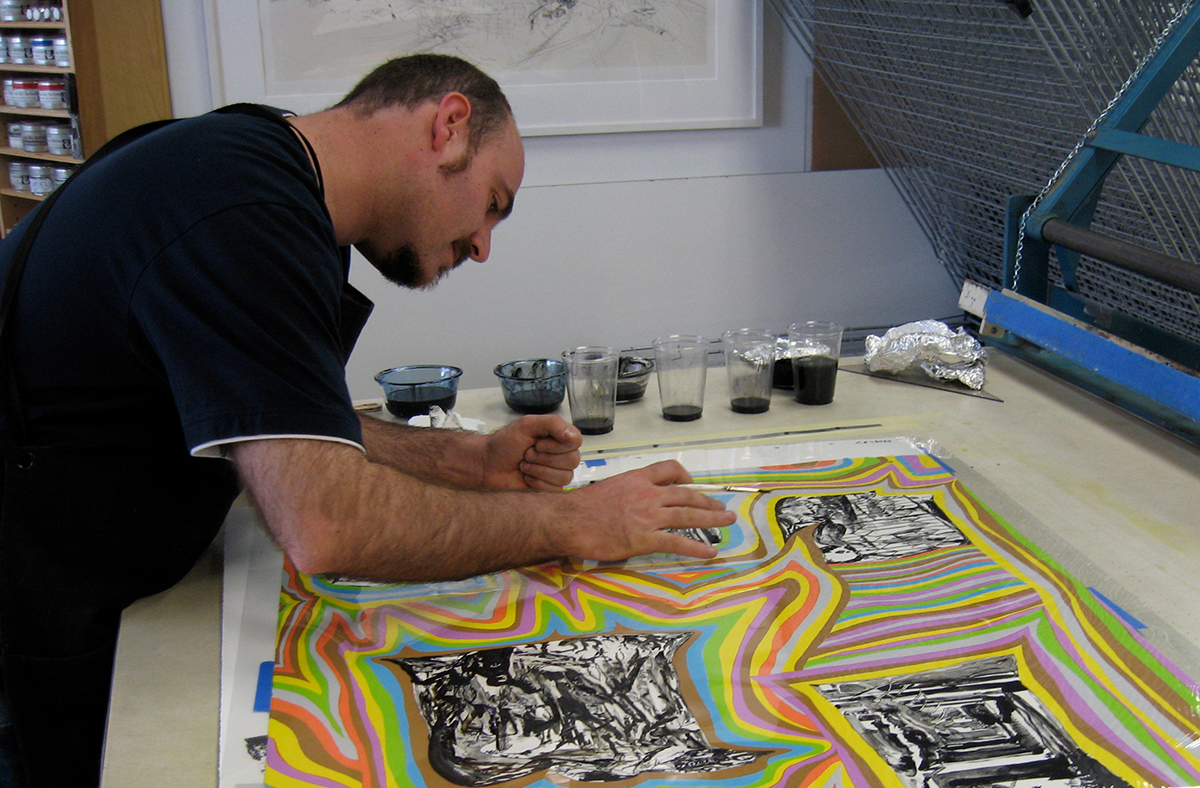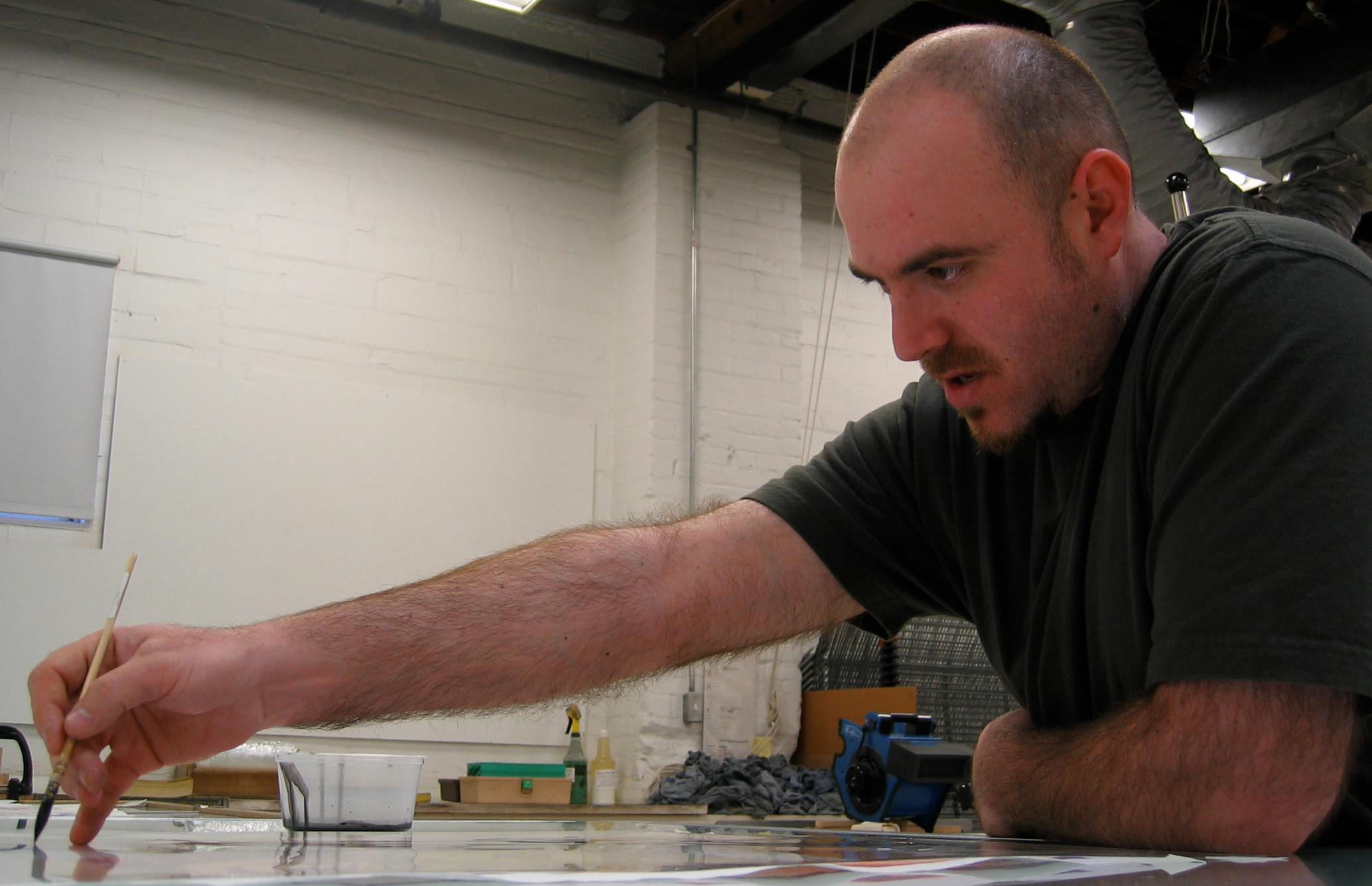
Born 1969, Buenos Aires, Argentina
Santiago Cucullu left Argentina just before kindergarten, settling with his parents (both lawyers) in a split-level house in Bethesda, Maryland. Being near Washington, D.C., was handy for Roberto Cucullu’s job and propitious for his artist son. It was in Washington, D.C., around 1995, that Santiago walked into a gallery and saw a drawing that the American artist Francis Ruyter had made directly on the wall with a Sharpie. “I didn’t know that was a thing,” Cucullu says.1 The first wall he painted on was at the Minneapolis College of Art and Design while pursuing an MFA (1999); he had decided to attend MCAD partly because he liked the local punk rock band the Cows. His BFA came from the Hartford Art School, West Hartford, Connecticut, in 1991.

Soon Cucullu’s trademark wall material became self-adhesive vinyl—common, everyday
Con-Tact paper from the hardware store. He liked the crisp edges, the flatness, and its cold, mechanical feel. Initially he hand cut each work at the exhibition site with an X-Acto knife; later his designs were prefabricated. He enjoys pulling together disparate images and letting them “rub up against each other and coexist relatively seamlessly,” he says. His wall installation
(2004) at the Hammer Museum in Los Angeles, for example, referenced Doc Martens shoes, the singer Dusty Springfield, and the spot where the Buenos Aires poet Leopoldo Lugones took his life. His piece in “How Latitudes Become Forms: Art in a Global Age,” 2003–5, organized by the Walker Art Center, Minneapolis, was a self-adhesive vinyl mural about the Italian Argentine anarchist Severino di Giovanni. Soon Cucullu turned to subjects he knew firsthand. For Green Hell (2014), he threw paint balloons against the wall, referencing the splatters he’d seen in Argentina, left over from long-ago protests. Other works feature airline blankets
, or vignettes observed in Milwaukee, Wisconsin, where he lives. Since 2012, he has made large-scale, black-and-white digital prints of images from his sketchbooks, which he affixes to the wall with wheat paste and sometimes installs with his ceramics or framed watercolors.
Other group exhibitions include “New Perspectives in Latin American Art” (2008), Museum of Modern Art, New York; Whitney Biennial (2004), Whitney Museum of American Art, New York; and “Dialogues: Bonnie Collura/Santiago Cucullu” (2000), Walker Art Center. Cucullu has had solo shows at the Milwaukee Art Museum, Wisconsin (2008); Museum of Contemporary Art, San Diego (2006); and Mori Art Museum, Tokyo (2004). He has received grants from Art Matters (2010) and Artadia (2003), among others, and has had residencies at Headlands Center for the Arts, Sausalito, California (2006); Arcus Project, Ibaraki, Japan (2004); Core Program at the Glassell School of Art at the Museum of Fine Arts, Houston (2001–2); and Skowhegan School of Painting and Sculpture in Maine (2001).
—Marla J. Kinney
Notes
Santiago Cucullu, phone conversations with the author, April–May 2020. ↩︎
- Cat. 90. Cucullu
- Cat. 91. Cucullu
- Cat. 92. Cucullu
- Cat. 93. Cucullu
- Cat. 94. Cucullu
- Cat. 95. Cucullu
- Cat. 96. Cucullu
- Cat. 97. Cucullu
- Cat. 98. Cucullu
- Cat. 99. Cucullu
- Cat. 100. Cucullu
- Cat. 101. Cucullu
- Cat. 102. Cucullu
- Cat. 103. Cucullu
- Cat. 104. Cucullu
- Cat. 105. Cucullu
- Cat. 106. Cucullu
- Cat. 107. Cucullu
- Cat. 108. Cucullu
- Cat. 109. Cucullu
- Cat. 110. Cucullu
- Cat. 111. Cucullu
- Cat. 112. Cucullu
- Cat. 113. Cucullu